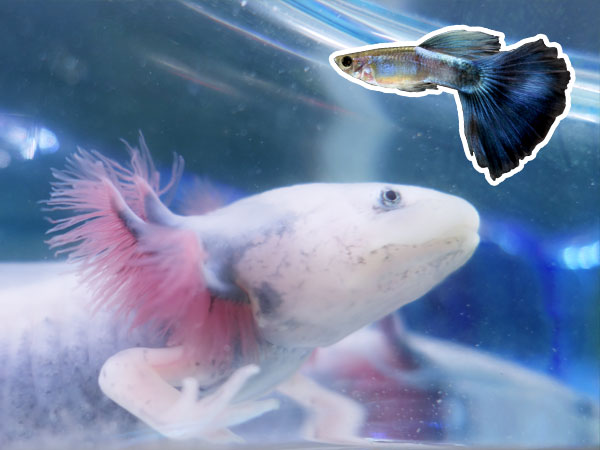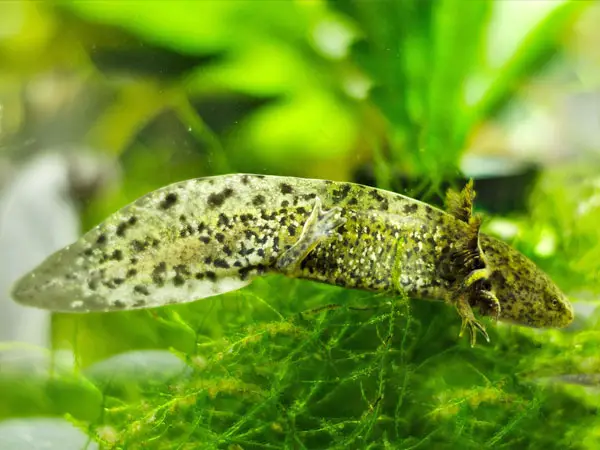Do you want to own axolotls, but you already have some fish in your tank? Or you want to add some fish next to your axolotl, and you don’t know what will happen. Will axolotl eat your fish?

The answer is yes, axolotls can consume fish, especially the smaller fish. In fact, many axolotl owners feed their amphibians smaller fish as a part of the diet, which goes to show that they will happily consume the fish. With larger fish species, this doesn’t usually occur, and especially if the fish has the ability to defend itself. But for smaller fish, it can happen.
That’s why you have to be wary if you want to keep axolotls with fish in the tank. It’s better to know which fish species will be better for axolotls and will not get eaten. That’s what we’re here for; we’ll talk about which fish species are more prone for being eaten by axolotls, and what you can do to reduce the chance.
Should You Feed Live Fish to Axolotls?
As we have already mentioned, many axolotl owners decide to feed the axolotls live fish, which the axolotls will gladly eat. In fact, axolotls are known for eating just about anything that comes in their way. So yes, they’ll eat the live fish, and you can have the fish as a part of their diet.
But, feeding the live fish to axolotls should be done with caution. First of all, live fish can have some parasites or diseases that can rub off on the axolotl, and can make your axolotl sick if you are not careful. That’s why the fish that you feed to axolotls should be thoroughly vetted, or you should avoid it altogether.
Live fish can be an important part of the axolotl’s diet. They provide several beneficial nutrients, such as proteins and fish fats that will keep the axolotl healthy. But they should be checked before you feed them.
For example, goldfish can carry several parasites that can threaten the life of an axolotl. The best way to feed them live fish is to breed the fish at home. If you can afford to, you should get a separate tank where you will breed the smaller fish.
What Fish Can Axolotls Eat?
Axolotls should only be fed the fish that will feed in their mouths. This includes the smaller fish that will not be too fast for the axolotls to be caught. Additionally, you can feed them the smaller fish with tweezers so that they won’t get away from the axolotls.
Some of the smaller fish species that can be fed to axolotls include:
- Guppies or other subspecies of guppies,
- Mollies,
- Goldfish (they should be vetted so they are without parasites)
- Other smaller and slow-moving fish.
We should also take a look at which fish are probably not the best for axolotls. As we know, these animals are not too fast when it comes to swimming and moving around, so it’s probably not the best idea to feed them fast-moving fish.
If you do so, you should consider feeding them with tweezers, or you should not feed them such fish altogether. Some of these fish species that you shouldn’t feed to axolotls include:
- Tetras
- Danios
- Other schooling or fast-swimming fish.
Even if these fish are small enough for the axolotl to consume, they won’t be able to catch them, so they are not the best way to feed your axolotls. If you do consider live fish as a form of food, take a look at the fish above.
Can Axolotls Eat Fish Food?
Axolotls can eat fish food, especially the meat-based fish foods. These can include fish pellets or other types of food. Though, you would want to avoid feeding your axolotls plant-based foods as they are strictly carnivorous.
Another thing to keep in mind is that the fish food should in no way be the only source of food for your axolotls. You should try to keep as much variety as you can when it comes to the diet, and this includes various live foods, frozen foods that you can combine with the fish food.
As for the best type of food, you should avoid the pellets that can expand and can cause impaction for axolotls. Instead, opt for more compact fish foods that won’t expand as much when you put them in the water.
In order to keep a varied diet, you should try to incorporate live foods such as earth worms, trout, or salmon. Sure, these foods can cost quite a bit, but they should be added from time to time. They carry essential nutrients and minerals that are just not found in regular fish foods. Other foods that can keep a variety are crickets, grasshoppers, and bloodworms
Can Axolotls Eat Snails?
Snails can also be considered as a type of food for axolotls. Though, you will also want to be moderate with snails. If the axolotl eats too many snails, it can clog their intestines, which can lead to congestion, and even impaction.
Another thing to keep in mind is that you shouldn’t feed them snails with particularly hard shells. Instead, you can get smaller snail species and make sure that the shells are not too hard, or remove them first before you feed them to your axolotl.
Conclusion
Keeping a variety in the axolotl’s diet is essential for keeping them healthier for a long time, and ensuring longevity. Axolotls will eat live fish or frozen fish, but they should in no way be the only or primary source of food.
In addition, many fish species can be bad for axolotls, because they carry parasites and diseases that can spread onto the axolotls, causing them to suffer from these illnesses. Before you feed them the fish, make sure they are vetted properly. The best way is probably to breed the fish at home and feed them to your axolotls.





My axolotls love the two tiger gouramis I have. Granted it’s a 55 gallon but nonetheless. My gouramis are always hanging around and next to my axolotls. Never once has my axolotl attacked my fish. That’s just my experience though. Good luck
Hey! Thanks for sharing your experience with us! I’m sure there are other special cases where axolotls will do ok with fish, but these are rare.